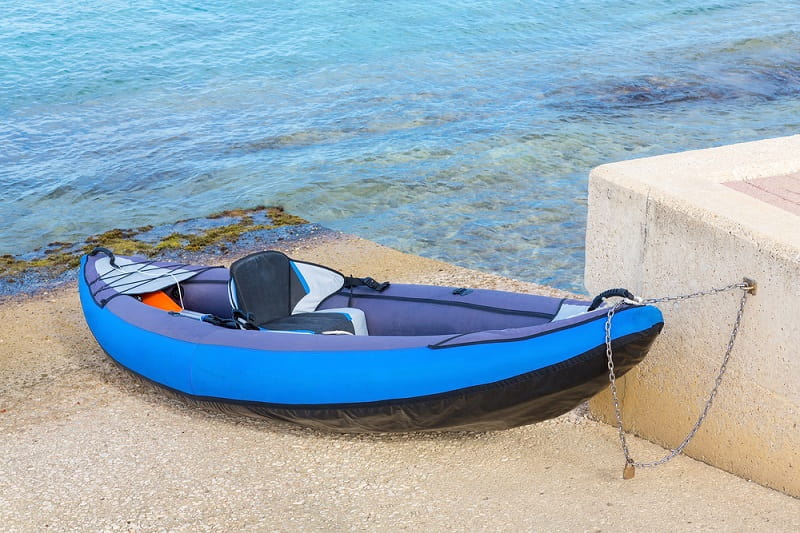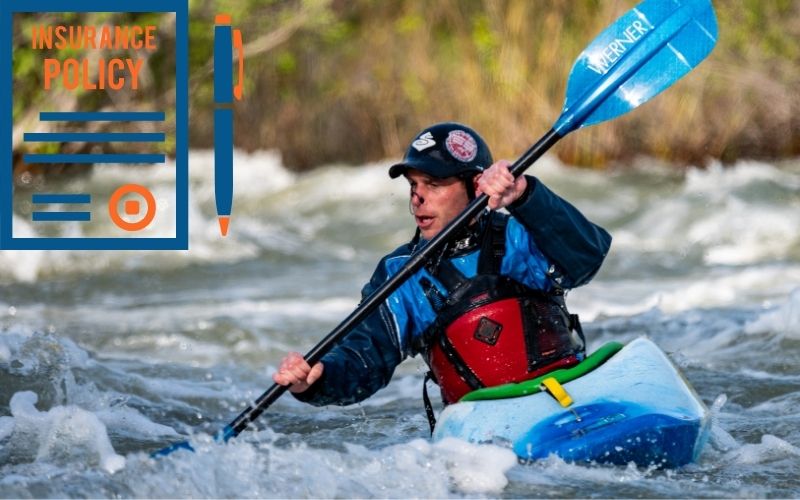Insurance protects you and the things you love. But what about your kayak?
You spend endless hours gliding in your kayak through calm waters and bouncing over rapids.
You carefully cover your kayak when you store it. You keep it clean to avoid staining and skin damage.
Still, you know the unexpected can happen. So you want to know if insurance is available to protect kayaks. If it is, what type of insurance coverage can you get?
What is an acceptable amount to pay for kayak insurance? Is insurance optional or mandatory?
Let’s do some research and find out.
Table of Contents
Are You Required To Have Insurance?

The regulations regarding watercraft insurance vary by state.
Required insurance usually depends on whether your vessel has a motor and the size of that motor. Even if your vessel has a motor, if it is less than 50 horsepower, insurance is typically not required.
So, from a legal standpoint, kayaks generally do not need to be insured.
But you may be required to have insurance if you are financing the purchase of a kayak. As with any loan, the bank wants to know that it will get its money back.
Since kayaking can be dangerous, banks typically insist that you purchase insurance. Just as banks require home insurance in case of fire and natural disasters, kayak insurance is needed in case of damage, theft, accidents, or natural disasters.
Certainly, it is to your advantage to ensure your kayak. Even if you purchase your kayak without financing, you don’t want to lose your entire investment because of a single incident.
Most owners choose to store their kayaks in their garages or in storage facilities. But if you store your kayak outside, it is very important to have insurance coverage.
Some kayakers even choose to keep their kayaks tied to a dock or moored at a marina. They want to be insured in case of theft or storm damage.

You also need protection in case you do damage to another boat.
The unpleasant thought of injuring someone else is compounded when you need to pay them damages for their injuries. If their injuries are serious, you may be paying them for the rest of their lives.
No matter how careful you are, you never know how safety-conscious other boaters are.
You don’t know if other kayakers and boaters are intoxicated, or if they are inhibited by illegal substances.
If they cause injury to you or damage to your kayak, there is no guarantee that they will have insurance. Your entire investment could be wasted by the carelessness of others.
If you have a kayak that seats more than one person, having insurance is even more important.
Imagine if your friend is injured. How would you feel if you were unable to pay the expenses they are burdened with?
You started kayaking to have fun and to enjoy the sport. You don’t want to worry about what will happen if an accident occurs.
Can You Get Kayak Insurance?

There is an assortment of insurance options available for non-motorized boats, including kayaks.
Collision and comprehensive insurance cover events that happen that you could not control. These plans also give you coverage when you collide with another boat or object. The insurance also pays for damages from capsizing.
Damage caused by a storm may be covered. Damage caused by floating debris may be covered. If you flip over and your kayak is damaged by rocks, that may also be covered.
Liability insurance pays the cost of damages that you cause with your kayak. If you crash into another kayak and cause damage to it, liability insurance may cover it.
If someone is injured in a kayak that you crash into, that should be covered. Should you accidentally break someone’s fishing lines or traps, those expenses may be paid.
Should you become injured in an accident, your medical bills can be covered. When you use a two-person kayak, and the other person is injured, their medical expenses may also be paid.
The accident would need to be covered by your plan. It is possible for a policy to have exclusions, so you want to ask your insurance agent if any type of accident is not covered.
Uninsured boater insurance covers accidents that are caused by someone else who has limited or no insurance. If they cannot pay, you would receive payment from your insurance company.
Some boaters are so excited to get their boats in the water that they fail to consider the possibility of an accident.
Others may recognize that accidents are possible, but they may choose to ignore this and gamble that nothing will happen. You need to protect yourself from their negligence.
If you have homeowner’s insurance, check your policy to see if kayak coverage is included. If not, you may be able to add kayak coverage at a reasonable price.
Remember that a deductible may apply. So you may have to pay an amount yourself before the insurance begins to pay for damages.
Not all policies are the same, so be clear on what is covered and the amount that the coverage pays.
How Much Can You Expect To Pay For Kayak Insurance?

The cost of kayak insurance will depend on whether you are covering only your kayak or if you are also covering a kayak trailer.
It will also depend on the amount of your deductible and the amount the policy will pay for covered events.
Since you are not required to have coverage, the cost will also depend on if you are getting comprehensive coverage and uninsured boater insurance.
You can expect to pay an average of $100 or more per year with a commercial insurance company. The factors affecting the price include the year, make, and model of your kayak.
Your credit history and the zip code in which you live also have an effect on the cost. If your kayak has a value of more than $1,500, according to Insurance Match, the policy cost may be higher and may include restrictions.
In this case, you may need to provide receipts showing the cost of your kayak and any accessories you wish to include in the coverage. An appraisal of your kayak may be required.
While adding your kayak to your homeowner’s insurance policy may have a lower cost, you are more likely to find limits to that coverage.
If you wish to cover life jackets, paddles, and other accessories, the amount the insurance pays for damage to these may also be limited.
Usually, policies will cover your kayak for damages no matter where they happen. But some policies may exclude international waters and other waters that are known to be dangerous.
So, consider where you plan to use your kayak, and decide what accessories you wish to include in your coverage as you compare policies.
Conclusion
You are not required to have insurance for your kayak. But it is very important to have.
You never know when you will have an accident, or if you may be the victim of someone else’s negligence. You want to be able to protect the investment you made when you purchased your kayak.
Different types of insurance are available. These include liability, comprehensive, collision, and uninsured protection.
You can expect to pay $100 or more yearly. You may find lower premiums, but these policies may offer limited coverage or high deductibles.
Some boaters attach their boats to their homeowner’s insurance policies. These policies may have lower rates, but may also include significant restrictions.
When comparing policies, read the fine print. If you do not understand anything in the agreement, insist on clarification from the agent.
Once you secure a quality policy, you can relax and have the fun you craved when you purchased your kayak.

I created this site to help people – to help you – with your boat problems. Instead of helping one person at a time, I want this website to be the “one-stop-shop” for everyone’s boating concerns. Read more.

